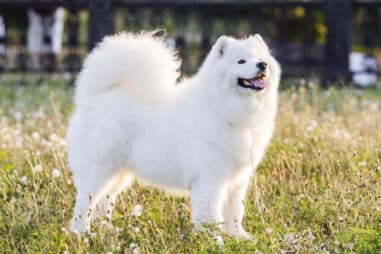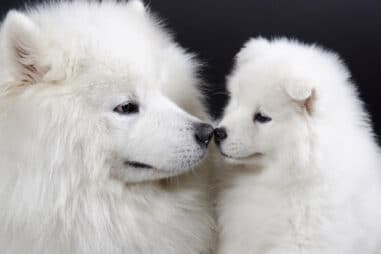Many Samoyed owners are curious about the possibility of their dogs being of different colors. And for that reason, there is a lot of wrangling over whether black Samoyeds really exist. If they are a genuine Samoyed breed or not.
Some people say that they’re just Siberian huskies with different coloring. Others insist that there is a difference between the two breeds. To many people, it’s confusing as heck.
Are black Samoyeds different dogs altogether, or are they just regular Samoyeds with a different coat color? This composition intends to look into this subject matter and answer that question once and for all!
What Colors Do Samoyeds Come in?
Most Samoyeds are white, but they can also come in other colors such as cream, biscuit, and a white-biscuit mix. Some people may refer to these other colors as variants, but they are all considered Samoyeds nonetheless. While the different colors may not be as common as white Samoyeds, they still make up a significant part of the breed.
Many people believe that the color of a Samoyed’s coat determines the dog’s personality and behavior. For example, black Samoyeds, which are very rare, are often seen as being more independent than their white counterparts. On the other hand, others think that there is no difference between the different colors of Samoyeds and that it is only a matter of personal choice.
In the end, it is up to the individual owner to decide what color of Samoyed they want. Ultimately, it is the personality and temperament of the dog that matters most, not the color of his coat.
Can Samoyeds Be Other Colors?
The answer to this question depends on what you mean by “other colors”. Technically, Samoyeds can be any color that their parents are. But, in the United States, Samoyeds are almost always white. This is because the American Kennel Club (AKC) only recognizes white Samoyeds as purebreds.
If you are asking if Samoyeds can have markings or spots of other colors, then the answer is yes. In fact, many Samoyeds have markings that are not white. These markings can be any color, including black, brown, tan, and gray.
So, the answer to the question “can Samoyeds be other colors?” is yes – but only if their parents are other colors, too. If you are looking for a Samoyed with markings that are not all white, then you can find them – but they may not be AKC registered.
Can Samoyeds Only Be White?
While the vast majority of Samoyeds are white, they also come in other colors such as biscuit, cream, and a white biscuit mix. So, why are so many people convinced that all Samoyeds must be white?
There are several underlying reasons why people are under the impression that Samoyeds should only be white. One is because that is the way they have always seen them. Others believe that only white Samoyeds are purebred (as per American Kennel Club), while black and brown dogs are somehow “impure”. Please take note that black and brown Samoyeds are very rare. They are very hard to find because they are one in a million.
If you go back in the annals of history, you will see that black Samoyeds have been spotted, though. But further looking at them would prove that those dogs were actually bred from other breeds. Hence, they can’t be considered “pure” Samoyed. Purebred Samoyed only comes in white, biscuit, cream, and a mix of biscuit and white.
Are you familiar with the Swedish Lapphoun dog? People who encounter this breed for the first time often think it is a black Samoyed. They would mistake the Swedish Lapphund dog for a Samoyed, the black version of the breed. But later on, they would be proven wrong.
And finally, some people may simply find the white coat to be more attractive than other colors. Moreover, because Samoyeds have such thick fur coats, their skin and coat color can often appear lighter than it actually is. This can make it difficult to determine a Samoyed’s true color, especially if they are not purebred.
But despite their snowy white fur, Samoyeds do come in other coat colors, most of which are scarce, especially the black ones. And there is nothing wrong with a black or brown Samoyed. In fact, many people believe that these darker-colored Samoyed dogs are just as beautiful as their white counterparts. So, if you happen to see a Samoyed that’s not white, don’t be taken aback by its color. It will not make them any less of a dog.
Why Are Samoyed Only White?
Samoyeds come in other colors, too, not only white. Aside from pure white, these dogs also come in cream, biscuit, or white and biscuit mix. In fact, the American Kennel Club (AKC) recognizes only those colors. They would put all other colors to the other side of the equation as “non-pure”.
So why are Samoyeds often only seen in white?
The most plausible reason for this is that the white Samoyeds are simply more popular. People only sought out white Samoyed, and many are thus unaware that other colors exist for this breed, too.
Samoyeds have been featured in many movies and TV shows, such as The Shaggy Dog and 101 Dalmatians. As a result, white Samoyeds are more well-known and therefore more popular than the other colors.
Another possible reason is that the white Samoyeds are simply more common. In the early days of this canine breed, most of them were white. As time went by, they became more popular, and other colors were introduced, but the white ones remained the most common because they are sought out.
Or it might be that white Samoyeds tend to stand out more than their colored counterparts. This is especially true if they are shown in the competition since they will be the only dog of their color.
Whatever the reason, if you’re looking for a Samoyed, you’re most likely to find one in white. But don’t discount the other colors – they’re just as beautiful, and make great pets, too!
Is Samoyed Always White?
Samoyeds are typically white, but they can also come in cream, biscuit, or a mix of white and biscuit colors. Please note that there is nothing unusual when you see these dogs having patches of different colors on their body. So, while the majority of Samoyeds are white, it is not always the case.
One of the reasons that Samoyeds are often white is because of their thick fur. The fur helps to keep them warm in cold weather, and it also protects them from the sun. The fur can be so thick that it can sometimes be hard to see the dog’s skin color.
Another reason that Samoyeds are often white is because of the way that they are bred. All-white Samoyeds are much more popular in the local pet market. Hence, the vast majority of Samoyed breeders choose to produce more of them. Thus, the majority of Samoyeds that are born are white because they have a white pedigree.
Yet, it is important to note that not all Samoyeds are white. As indicated above, other colors such as biscuit, cream, or white and biscuit mix color of Samoyeds exist.
Black and brown Samoyeds might exist somewhere, but they are extremely rare. And if you happen to find one, you will need to shell out a good amount of money to have it. Their scarcity is what’s making them far more expensive than the standard white ones, which are more common
Why Is My Samoyed Not White?
There are many different reasons why a Samoyed may not be white. One possible reason is that your dog is simply not purebred. Depending on what other breed your dog has in him, his coat color would vary.
Another possibility is that your dog’s genes may have been diluted by mating with another breed. In this case, you may still see some traces of white fur on your Samoyed, but he will not be completely white.
A third possibility is that your Samoyed’s coat has been bleached out by the sun or by chemicals. This can happen if your dog spends a lot of time outdoors or if he lives in an area where the water is high in chlorine.
Finally, some Samoyeds just have a naturally lighter coat color than others. Despite there being no particular reason why this is the case, owning a Samoyed of this type means you have to accept it, wholeheartedly.
No matter what the underlying reason is for your dog’s non-white fur, remind yourself that there’s nothing wrong with him. You should be proud to own such a beautiful and loving dog because others can only dream of having one!
Why Is My Samoyed Puppy Yellow?
There are a few different reasons why a Samoyed puppy may be born with a yellow coat. One reason could be that the puppy is carrying genes for both black and yellow coats. Another reason could be that the puppy is not getting enough of the nutrient biotin, which handles pigmentation in their fur.
Biotin deficiency can also make the puppy’s nails brittle and thus fall off easily. If you are worried that your Samoyed puppy is not receiving enough biotin, you may have a blood test done on the pup to screen for biotin deficiency. If the puppy is found to be biotin-deficient, your veterinarian may recommend a biotin supplement.
So, if your Samoyed puppy has a yellow coat, don’t worry – it’s just his or her genes at work! The yellow coat should not always be taken as a sign of a bad health condition. Thus, your puppy will grow up to be just as healthy as a white Samoyed. In fact, many people even think that the yellow Samoyeds are prettier than the white ones!
How Do You Keep Samoyed Fur White?
There is no one definitive answer to this question as there are a variety of ways to keep Samoyed fur white. The truth of the matter is that it is a case-to-case basis. Some methods are more effective than others, but it is important to find the solution that works best for you and your dog.
One way to help keep your Samoyed’s fur looking its best is to brush it periodically. This will remove any dirt or debris that may have built up, and it will also help distribute the natural oils on the dog’s skin throughout the fur. Brushing your Samoyed with a harsh brush could damage the delicate fur, so use a soft-bristled brush instead.
Another option is to give your dog a regular schedule for bathing time. This will help remove any dirt or grime that may have built up, and it will also help keep the fur clean and healthy.
When giving your Samoyed a much-needed bath, it is important to only use a dog-specific shampoo. Veer away from using human shampoos in washing your dog or giving them a much-needed bath. Most of the time, human shampoo formulation can be too harsh for your canine’s skin and coat. Thus, this may eventually induce irritation on the skin itself.
If you are looking for a more permanent solution to keep your Samoyed’s fur white, you may trim your pooch’s coat from time to time. This will help keep the fur looking neat and tidy, and it will also make it easier to clean and maintain.
No matter what method you decide to take, it is important to be consistent in your efforts. If you only brush your dog once a month, for example, the fur will become matted and tangled over time. Keeping your dog’s fur healthy and white can be accomplished by brushing them regularly.
How Do You Whiten a Samoyed?
There is no one definitive answer to this question, as the best way to whiten a Samoyed may vary depending on the dog’s individual coat color and type. But, some methods that may be effective include the use of baking soda or hydrogen peroxide mixed with water to create a paste.
Or you can try using a specialized commercial-grade whitening shampoo. Keep in mind though that it is important to test any cleaning/whitening solution on a small area of the dog’s coat first. This measure will help make sure it will not irritate the skin.
In general, keeping a Samoyed’s white coat clean and healthy should come as your first and top priority. This is so true if your main goal really is to preserve the bright, immaculate appearance of its coat. After that, everything else will fall into the right place.
Bathe your dog at least once a month and brush its coat at least five times a week. Regular and frequent brushing is essential in removing dirt, dust, or other debris deposits that may have accumulated on its coat. Know that these foreign materials, too, can induce staining or discoloration on their immaculate white coat.
Additionally, keeping the dog’s living environment clean will help cut the amount of dirt and dust that may be tracked on its paws and coat.
Can You Get Black Samoyeds?
Yes, it is possible to get black Samoyeds. But you have a very slim chance for this as black Samoyeds are very, very scarce. The sheer paucity itself will make you think that they don’t exist. It would be one in a million as a black Samoyed is not very common. However, the Samoyed breed dog comes in a variety of hues.
According to the AKC (American Kennel Club), black coats in a “Samoyed” do not qualify for them as a breed standard. There is a high chance though that dogs that look like black Samoyeds are actually of mixed pedigree or may be entirely different breeds.
Your chances of coming across a black Samoyed puppy are very slim to none. However, there are a handful of other breeds that have a close semblance to a “black Samoyed”.
Below are some alternative breeds you may want to consider if you’d like to own a black Samoyed but can’t seem to find one.
Belgian Sheepdog: The Belgian Sheepdog is a medium-sized working dog. Like the Samoyed, they belong to the herding category of the American Kennel Club.
Female Belgian Sheepdogs typically weigh around 45 to 60 pounds (20.4 kgs to 27 kgs), while males weigh 55 to 75 pounds (25 to 34 kgs). These dogs are exceedingly docile and highly trainable, lively, and intelligent.
With regard to the breed standard for a Belgian Sheepdog, the only acceptable color for this canine breed is black and nothing else. It’s okay if their chest area does have some small white streaks as well as on the pads of their feet and toe tips on their back legs.
Sometimes also their muzzle and chin would have white markings. Such features do not disqualify them as purebred.
Eurasier: A Eurasier weighs between 40 and 70 pounds (18 to 32 kgs) and is a medium-sized breed. In contrast to the Samoyed, they come in a wide range of different colors, including black, red, and fawn. These dogs are intelligent, gentle, and calm.
Pomeranian: Pomeranians offer the same fluffiness as Samoyeds but in a smaller package. Despite their size, these fluffy dogs are highly energetic and lively. There are many colors to choose from, such as black, white, and red.
Mutts: There may be dogs at your local rescue center that look like black Samoyeds. Look hard enough and you may find a dog that looks like one but has distinct color variations.
Can Samoyeds Have Black Fur?
Every single Samoyed today has at least one single black hair on its body! A black Samoyed was one of the first Samoyeds. It gave the breed its black lips and eye rims. This is also the underlying reason why every Samoyed has only a single black hair.
The Samoyed breed of today is a pure white dog. Although extremely rare, some have black fur. The black Samoyed is a color variation of the Samoyed. Black Samoyeds were once common in their native Siberia, but they are quite rare now.
The black coat of the Samoyed is attributable to a recessive gene. This means that both parents are carriers of a black Samoyed gene so that a black Samoyed could be born. Because of this, black Samoyeds are quite unusual.
If you’re interested in owning a black Samoyed, be prepared to pay a premium price because they are few and far between. Black Samoyeds are often sold for more money than their white counterparts.
So, if you’re looking for a rare but beautiful Samoyed, consider a black one! But expect as early as now that it is going to be an arduous quest.
Why Does My Samoyed Have Black Hair?
There are a few reasons why a Samoyed dog would have a few dark hairs. The most common reason is that they’re getting older. As dogs get older, the hue of their hair may start to change color. Some Samoyeds also have dark hair around their ears, which is normal.
But sometimes black hair can be a sign of a health problem. If your Samoyed develops significant patches of black hair, you should take him to a nearby veterinary clinic. Do the same thing also if your pooch displays other indicator signs like weight loss or low appetite. He may have a health condition that needs treatment.
In most cases, though, black hair in Samoyeds is perfectly normal. So don’t worry if your Sam has a little streak of black hair mixed with white – it’s perfectly normal. But if you notice any changes in your dog’s coat color or if he seems to be unhealthy, take him to the vet right away.
Are There Brown Samoyed?
Brown is not a recognized color for Samoyeds. The Samoyed Club of America recognizes only white, biscuit, and cream & white as standard coat colors for the breed. Anything else is considered a disqualification for the show ring.
Samoyeds and Pekingese are the only breeds with a biscuit coat color. The biscuit Sammie is yellow and brown in medium saturation and brilliance. The coat is not as dense as that of other colors and can be seen through when held up against the light. This coloration is unique to Samoyeds and Pekingese and is not found in any other breed.
Of course, that doesn’t mean you can’t find a brown Samoyed if you really want one. Some breeders may have brown dogs in their litter, but they won’t be able to show them or register them with the AKC. If you’re looking for a brown Samoyed, your best bet is to check with rescue organizations or look for a mixed-breed dog that has some Samoyed in him.
While brown isn’t an accepted color for Samoyeds, there are many other beautiful colors to choose from. So, if you’re looking for a Samoyed, don’t rule out the biscuit-colored dogs. They may not be eligible for the show ring, but they’re just as loving and adorable as any other color of Samoyed.








